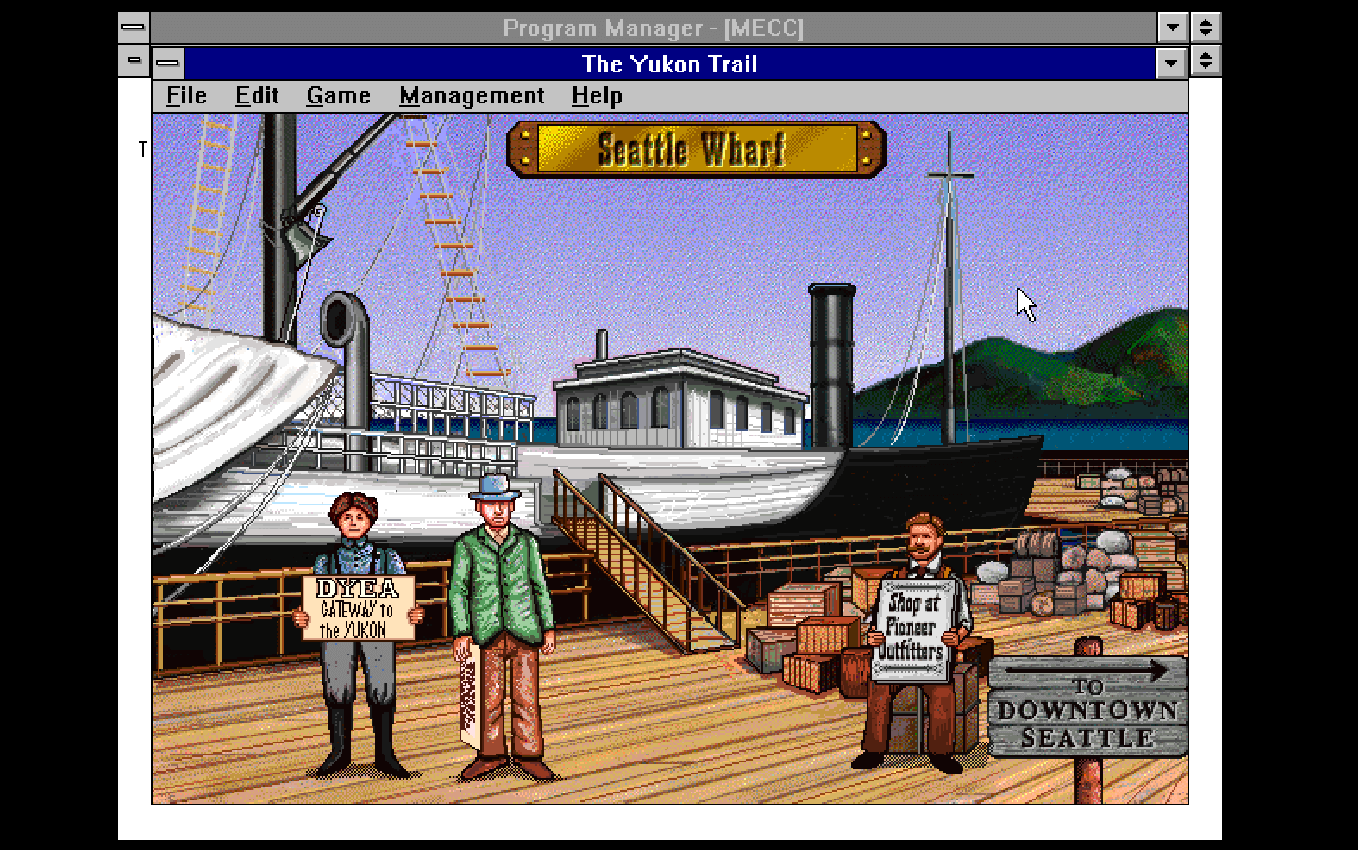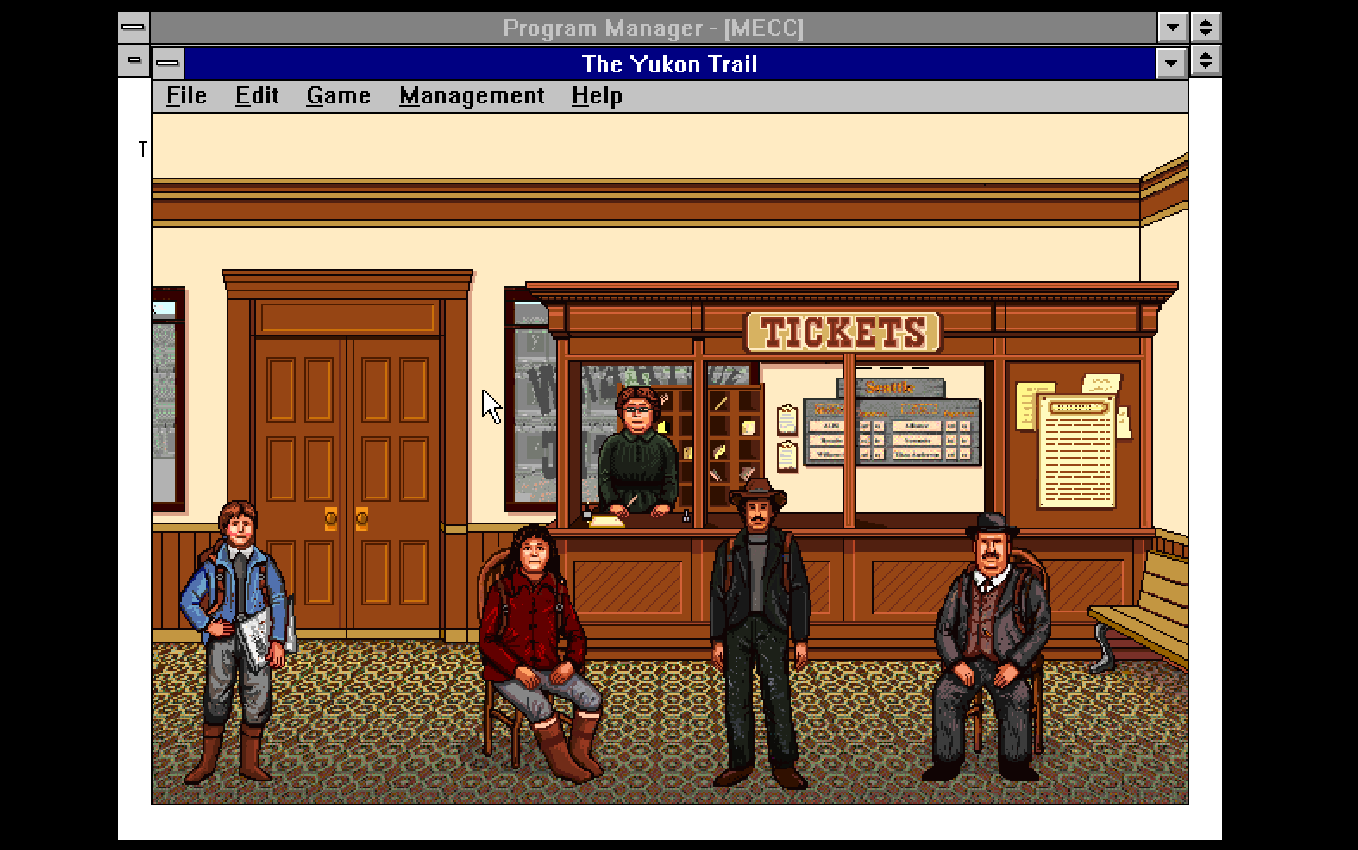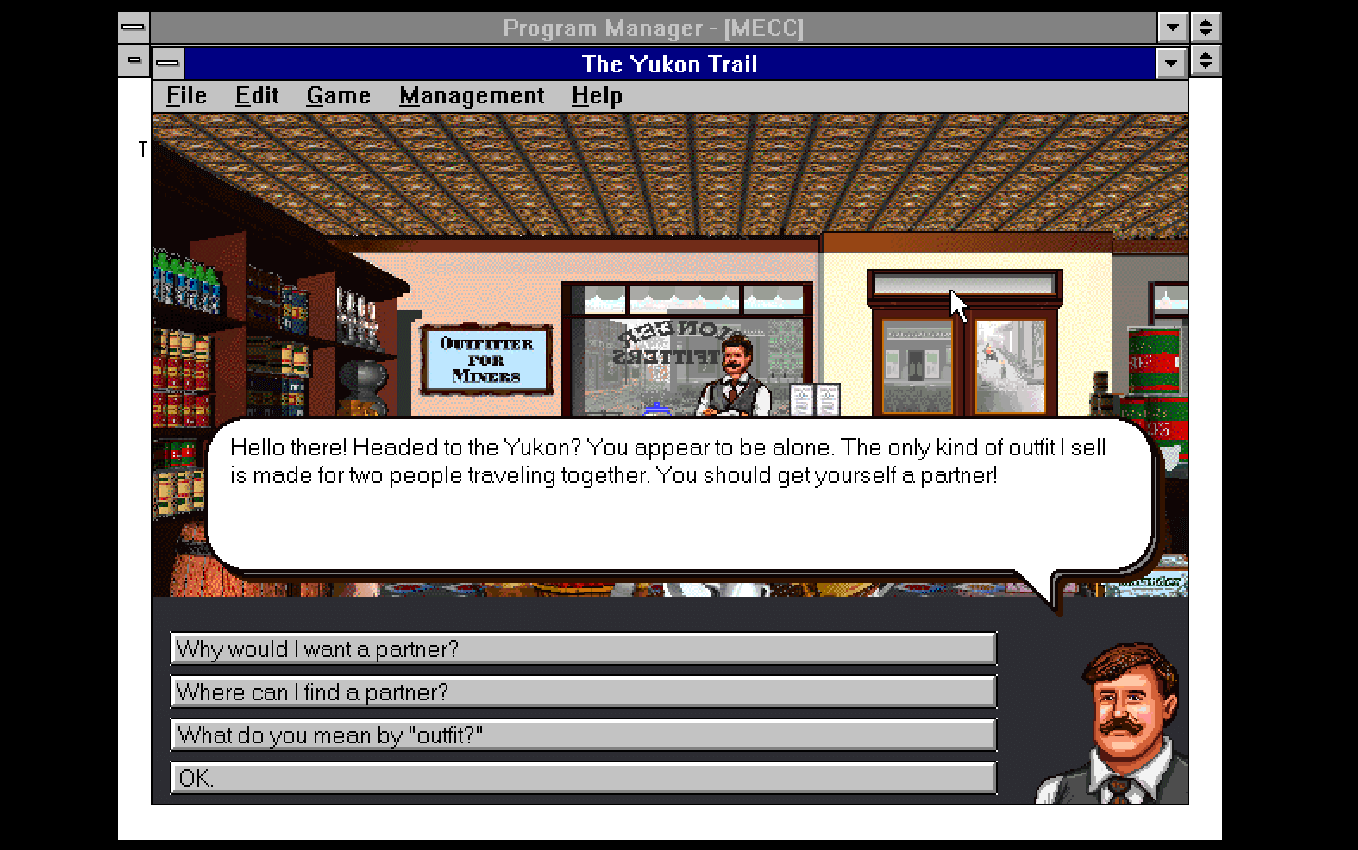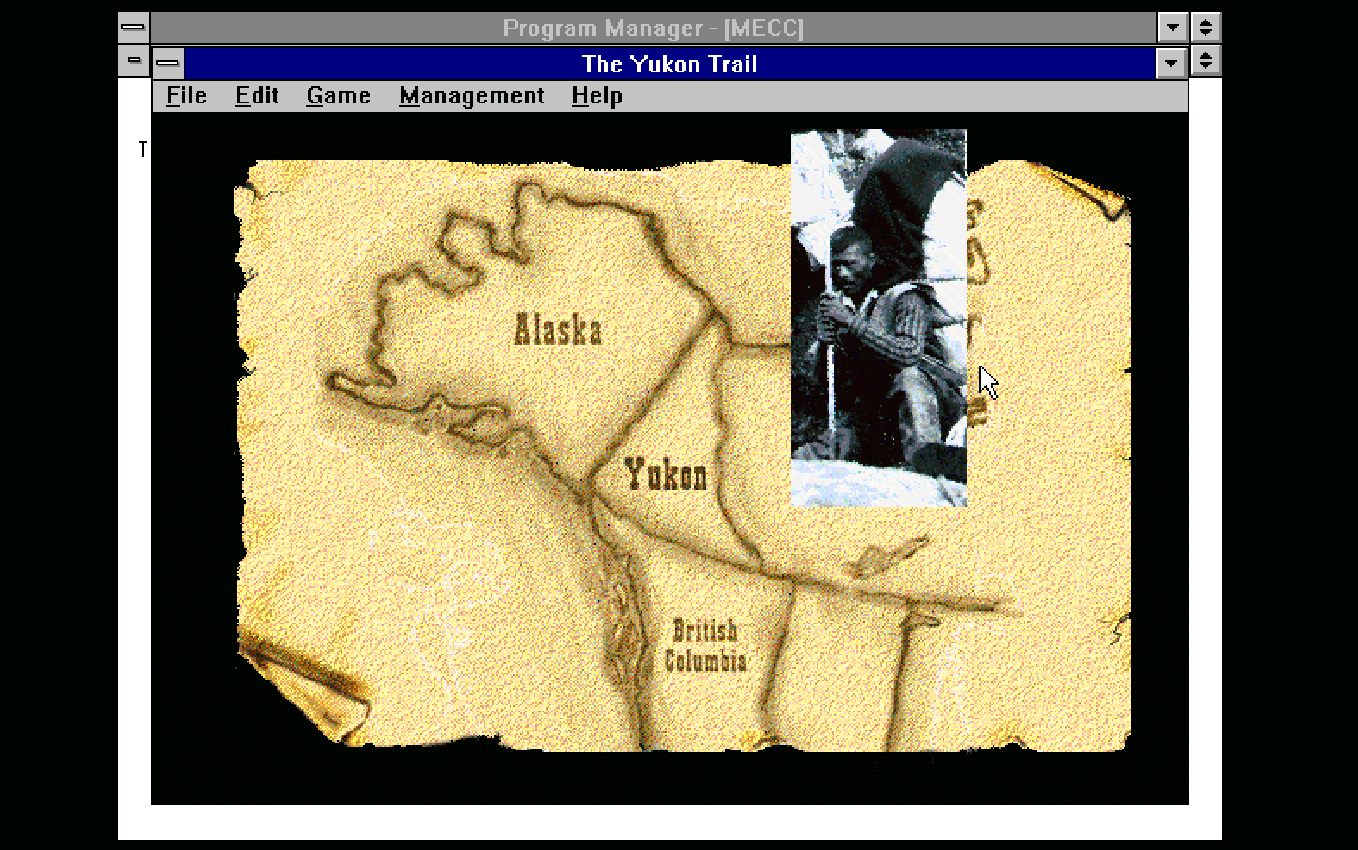The Yukon Trail is a spiritual successor to the renowned Oregon Trail series, but it transports players to the Klondike Gold Rush of the late 19th century. In this interactive adventure, players embark on a journey that commences in Seattle, as they make critical decisions about supplies, choosing a partner, and planning their travel to Alaska.
Their ultimate goal is to navigate treacherous waters, arrive at Dawson City, and stake their claim to mine for gold. The game is enriched by the presence of the famous author, Jack London, and authentic 19th-century photographs that provide a vivid glimpse into life during that era.
The Klondike Gold Rush Adventure
The game kicks off in Seattle in August 1897, just before the actual Klondike Gold Rush. Players are faced with the initial task of selecting one of four potential partners, each offering unique advantages. Afterward, they purchase tickets for a ship to either Skagway or Dyea.

The cost of tickets varies depending on the departure date, making immediate departures more expensive, while later departures are more budget-friendly. Players can also choose to buy equipment and supplies or wait until they reach Alaska.
However, it’s wise to be cautious when seeking advice from their partner, as their suggestions may not always be the best.
Upon arriving at Skagway or Dyea, players can buy supplies, engage in gambling, or gather vital information. The gambling options involve a War card game or a shell game, but luck might not always be on your side. Fortunately, you can disable gambling in the game settings.
As you embark on your journey, you must decide between the White Pass Trail, which is longer but easier, and the Chilkoot Trail, which is shorter but more challenging.
Additionally, players have the option to hire packers in these cities to transport their supplies to the respective trails, though this service comes at a significant cost and might not be accessible for everyone.

The Trail: A Test of Decision-Making
The Yukon Trail is a game of decision-making skills. At various points along the trail, players are presented with numerous choices, each with potential consequences.
One critical decision is the amount of load to carry personally. A smaller load allows for shorter daily distances, but the journey becomes significantly more challenging as winter approaches.
On the other hand, a larger load increases the risk of injuries to the player or their partner.
Midway through the trail, players and their partners stop at a camp where they can buy or sell goods before ascending the mountain pass leading to the Canada-US border. Here, they must pay a toll to enter the Yukon Territory, and the North-West Mounted Police enforce strict rules.
They require each person to carry 1,000 pounds of food and impose taxes on imported goods. Failure to meet these requirements results in losing the money you have.
Throughout the journey, you’ll encounter various random events, such as injuries, food theft, rockslides, crowded conditions, abandoned animals, and sudden adverse weather. These events add an element of unpredictability to the game and challenge players to adapt to changing circumstances.

Periodically, players stop at landmarks along the way, where they can delve into the historical facts about each location. These landmarks include the Dead Horse Trail, totem poles, and three notable rapids: Miles Canyon, White Horse Rapids, and Five Finger Rapids.
The River: Navigating the Yukon
Upon reaching Bennett Lake in Canada, players meet the legendary Mountie Sam Steele. During the winter months, they must acquire a whipsaw if they don’t already have one and build one of three types of boats.
Once spring arrives and the ice melts, players and their partners can set sail. The date of their arrival at Lake Bennett determines whether Sam Steele permits an immediate departure or requires a brief wait.
The speed on the river is determined by the type of boat chosen and its condition. Players can select from a dinghy, a raft, or a canoe. Each boat type has its advantages and disadvantages. The dinghy is balanced, the raft is slower but handles well, and the canoe is fast but requires skillful handling.

Along the river, players can engage in mini-games to navigate away from rocks and whirlpools. After these challenges, players can decide whether to repair the boat or build a different one.
Arriving in Dawson City, players receive a map of mining claims they can stake. Here, they meet Nellie Cashman and author Jack London. Once a claim is staked, the search for gold begins. As winter arrives, the game concludes, and players’ scores are determined by their total earnings, including gold mined.
While most claims yield modest amounts of gold, staking a claim at Cheechako Hill guarantees a prosperous outcome. Historically, this hill was initially overlooked by prospectors, earning its name from the term ‘cheechako,’ which referred to newcomers. However, it proved to be a goldmine with rich deposits.
Conclusion
The Yukon Trail offers a thrilling and educational experience that takes players on a historical journey through the Klondike Gold Rush. It challenges decision-making skills and offers a taste of the hardships and adventures faced by gold seekers during this era.
With rich historical details and engaging gameplay, it’s a remarkable addition to the educational gaming genre.

Playing The Yukon Trail online
The Yukon Trail game is accessible online on the web via web browser.
Whether you’re at home, at work, or at school, all you need to do is open your web browser and play this educational game to experience a piece of American history.


Incredible game. I like the Oregon Trail game, but this game is so much more in depth, and much more intriguing.
this game is good
Yukon trail is my fav game to play on ths site, even if its called oregontrail.ws. Why? Because The Yukon Trail is a 1994 educational computer game from the Minnesota Educational Computing Consortium (MECC), similar to their previous Oregon Trail series but set during the Klondike Gold Rush of the late 19th century. Players start out in Seattle and must make decisions concerning supplies, a partner, and travel plans as they head to Alaska before boating down a river to Dawson City and staking a claim to mine for gold. The game features the famous author Jack London and authentic 19th-century photographs that show what life was like back then.
The game starts in Seattle in August 1897 (right before the actual Klondike Gold Rush). The player must first choose one out of four partners. Each partner has unique advantages over the others. Next the player purchases two tickets for a ship to Skagway or Dyea. Tickets are more expensive for ships that depart immediately, and less expensive for those departing later. The player can buy equipment, food and other items, or they can wait until they get to Alaska. The player’s partner can offer their advice on making purchases, but their advice is sometimes unwise. Upon reaching Skagway or Dyea, the player can purchase any supplies, gamble or gather information. Gambling takes the form of a War card game or a shell game, but can be unfair and lead to losses for the most part. Gambling can be disabled in the settings.
When starting the journey the player can choose the longer and easier White Pass Trail or the shorter but more difficult Chilkoot Trail. The player can also hire packers in the two cities that would haul their supplies to the respective routes. The packers are very expensive, so they usually are out of reach for the average player.The Yukon Trail gives players plenty of opportunities to think about the situation, giving many options and many possible consequences for each event, thus building problem-solving skills. The initial choice players make on the trail, which can be subsequently changed, is the load personally carried. A smaller load results in the ground moved each day to become shorter (as some of the supplies have to be left behind and then returned for). Moreover, the trail becomes much more difficult to travel when encroaching upon the winter months. However, a larger load will result in a higher probability of the player or partner being injured.
Midway down the trail, the player and partner stop at a camp. They can then buy or sell goods before climbing the mountain pass leading to the Canada–US border where they pay a toll to pass into the Yukon Territory. The North-West Mounted Police will not let them pass unless they have 1,000 pounds of food per person. They are also required to pay a tax to bring goods into Canada. After the price for the tax is given, if the player does not have enough, the Mountie will simply take whatever money they have.
Along the trail, numerous random events may occur, including someone being injured (the player decides to continue at a slower pace or to rest), theft of food, rockslides, crowds of people or abandoned animals, and sudden inclement weather.
Periodically, the player stops at landmarks along the journey, where players can learn historical facts about each location. Some of these landmarks include the Dead Horse Trail, the totem poles, and the three rapids: Miles Canyon, White Horse Rapids and Five Finger Rapids.The player and partner arrive at Bennett Lake after hiking into Canada. While there, they meet the legendary Mountie Sam Steele. During the winter they need to acquire a whipsaw if they do not already have one and then build one of three boats. Once the spring arrives and the ice has melted, the player and partner can embark with their boat. Depending on the date of their arrival at Lake Bennett, Sam Steele will let them depart right away, or have them wait two or four days before departure.
On the river, the speed is determined by the type of boat chosen, and how much damage it has sustained. The choices for boats include a dinghy, a raft, or a canoe. The dinghy is balanced, the raft handles well but is slow, and the canoe is fast but handles poorly. There are a few minigames, which involve guiding the boat away from rocks and whirlpools. After the minigame, if the boat has been damaged, the player can choose to repair the boat or build an entirely different one.
The player and partner will eventually reach Dawson City, where they are presented with a map of mining claims they can stake. There, they meet Nellie Cashman and author Jack London. Once they have staked a claim, they can begin searching for gold. With the arrival of winter, the game ends. The player’s score is determined by the amount of money they have (from the entire journey, including gold). Most claims will yield small amounts of gold, but at least one claim can get you the high score.
One notable claim is Cheechako Hill, which is always available. Staking Cheechako Hill will always result in the player becoming rich. Historically, the initial wave of prospectors ignored Cheechako Hill because only a cheechako (newcomer) would think there was gold so high up the hillside, but it turned out to contain rich deposits.
this was why i love the yukon trail, and now I hope you will play it and enjoy it too!
I love yukon trail so much more than the oregon trail. Why? because The Yukon Trail is a 1994 educational computer game from the Minnesota Educational Computing Consortium (MECC), similar to their previous Oregon Trail series but set during the Klondike Gold Rush of the late 19th century. Players start out in Seattle and must make decisions concerning supplies, a partner, and travel plans as they head to Alaska before boating down a river to Dawson City and staking a claim to mine for gold. The game features the famous author Jack London and authentic 19th-century photographs that show what life was like back then.
Huh. I wonder if there is a limit to how much you can type.
Anyways, The game starts in Seattle in August 1897 (right before the actual Klondike Gold Rush). The player must first choose one out of four partners. Each partner has unique advantages over the others. Next the player purchases two tickets for a ship to Skagway or Dyea. Tickets are more expensive for ships that depart immediately, and less expensive for those departing later. The player can buy equipment, food and other items, or they can wait until they get to Alaska. The player’s partner can offer their advice on making purchases, but their advice is sometimes unwise. Upon reaching Skagway or Dyea, the player can purchase any supplies, gamble or gather information. Gambling takes the form of a War card game or a shell game, but can be unfair and lead to losses for the most part. Gambling can be disabled in the settings.
When starting the journey the player can choose the longer and easier White Pass Trail or the shorter but more difficult Chilkoot Trail. The player can also hire packers in the two cities that would haul their supplies to the respective routes. The packers are very expensive, so they usually are out of reach for the average player.The Yukon Trail gives players plenty of opportunities to think about the situation, giving many options and many possible consequences for each event, thus building problem-solving skills. The initial choice players make on the trail, which can be subsequently changed, is the load personally carried. A smaller load results in the ground moved each day to become shorter (as some of the supplies have to be left behind and then returned for). Moreover, the trail becomes much more difficult to travel when encroaching upon the winter months. However, a larger load will result in a higher probability of the player or partner being injured.
Midway down the trail, the player and partner stop at a camp. They can then buy or sell goods before climbing the mountain pass leading to the Canada–US border where they pay a toll to pass into the Yukon Territory. The North-West Mounted Police will not let them pass unless they have 1,000 pounds of food per person. They are also required to pay a tax to bring goods into Canada. After the price for the tax is given, if the player does not have enough, the Mountie will simply take whatever money they have.
Along the trail, numerous random events may occur, including someone being injured (the player decides to continue at a slower pace or to rest), theft of food, rockslides, crowds of people or abandoned animals, and sudden inclement weather.
Periodically, the player stops at landmarks along the journey, where players can learn historical facts about each location. Some of these landmarks include the Dead Horse Trail, the totem poles, and the three rapids: Miles Canyon, White Horse Rapids and Five Finger Rapids.The player and partner arrive at Bennett Lake after hiking into Canada. While there, they meet the legendary Mountie Sam Steele. During the winter they need to acquire a whipsaw if they do not already have one and then build one of three boats. Once the spring arrives and the ice has melted, the player and partner can embark with their boat. Depending on the date of their arrival at Lake Bennett, Sam Steele will let them depart right away, or have them wait two or four days before departure.
On the river, the speed is determined by the type of boat chosen, and how much damage it has sustained. The choices for boats include a dinghy, a raft, or a canoe. The dinghy is balanced, the raft handles well but is slow, and the canoe is fast but handles poorly. There are a few minigames, which involve guiding the boat away from rocks and whirlpools. After the minigame, if the boat has been damaged, the player can choose to repair the boat or build an entirely different one.
The player and partner will eventually reach Dawson City, where they are presented with a map of mining claims they can stake. There, they meet Nellie Cashman and author Jack London. Once they have staked a claim, they can begin searching for gold. With the arrival of winter, the game ends. The player’s score is determined by the amount of money they have (from the entire journey, including gold). Most claims will yield small amounts of gold, but at least one claim can get you the high score.
One notable claim is Cheechako Hill, which is always available. Staking Cheechako Hill will always result in the player becoming rich. Historically, the initial wave of prospectors ignored Cheechako Hill because only a cheechako (newcomer) would think there was gold so high up the hillside, but it turned out to contain rich deposits.
I love this game
WOWOWOWOOWOW this is so cool i am amazed i like the yukon trail more than oregon trail bc it is the best I love this game and i want to marry it. btw, what is 2x – 18/26?
Wow this company is history
wowzers! such a great and realistic game! yours truly, Eric
but why is your username bobby?
no questions, please
one of my favorite things to do is play old microsoft games or old games in general
you cant play old Microsoft games on this like solitare lol
i meant you can
Get away from him “anonymous user”